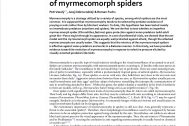Content
Myrmecomorphy is a strategy utilized by a variety of species, among which spiders are the most common. It is supposed that myrmecomorphy tends to be selected by predator avoidance of preying on ants rather than by blind ant workers. To date, this hypothesis has been tested mainly on invertebrate predators (mantises and spiders). We are the first to test whether an imperfect myrmecomorph spider (Phrurolithus festivus) gains protection against avian predators (wild adult great tits—Parus major) through its appearance. In a set of preferential trials, we showed that the ant model and the myrmecomorph spider are equally well protected against attack, though the attacked myrmecomorphs are usually eaten. This suggests that the mimicry of the myrmecomorph spiders is effective against avian predators and works in a Batesian manner. In this study, we have provided evidence toward the evolution of myrmecomorphy in response to selective pressure elicited by visually-oriented predators like birds.



